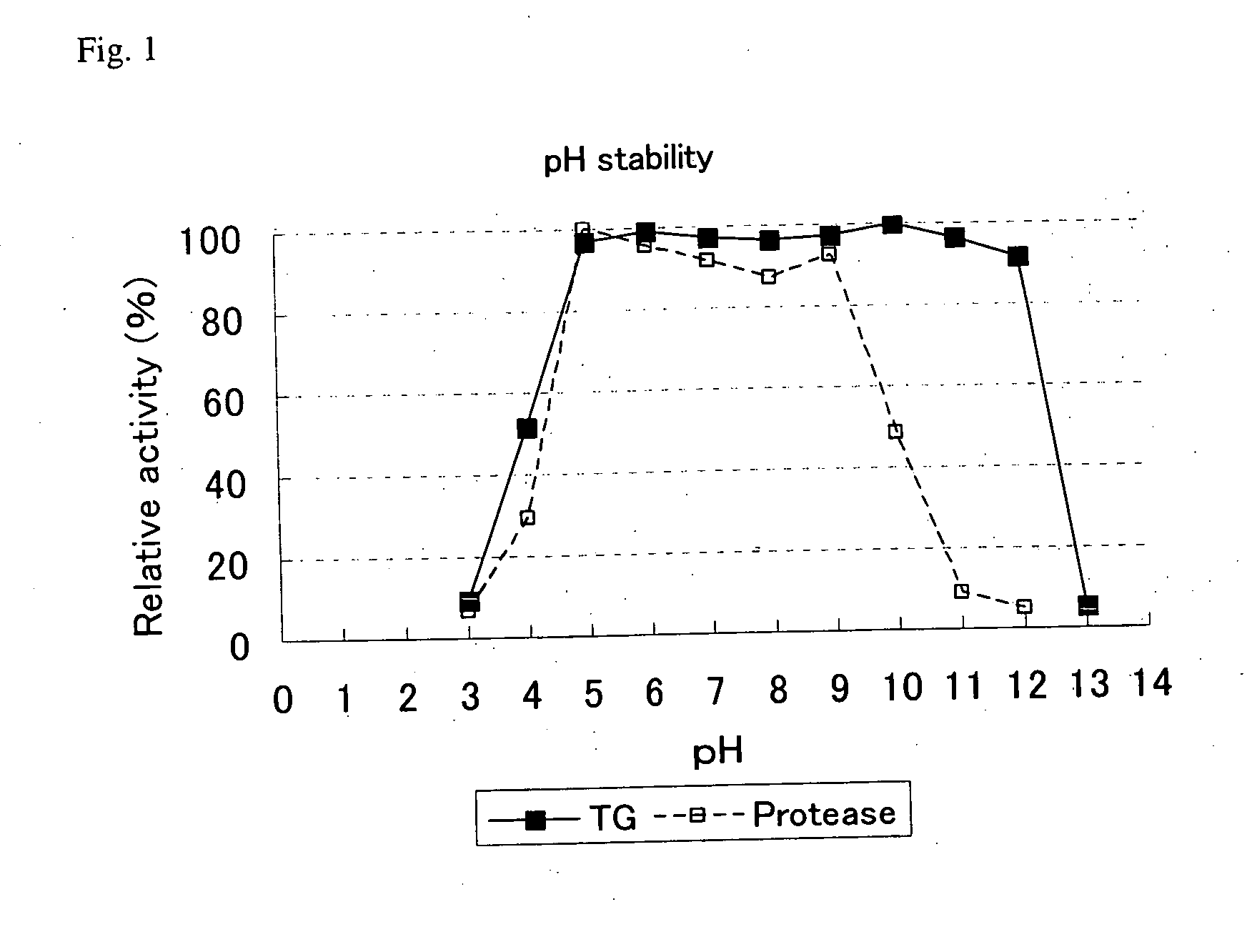Method for producing transglutaminase composition
a technology of transglutaminase and composition, which is applied in the field of transglutaminasecontaining products with reduced protease activity, can solve the problems of inability to selectively and efficiently deactivate or eliminate just protease activity without, and the presence of protease as an undesirable impurity in products containing transglutaminase is considered undesirable, etc., to achieve the effect of ensuring the quality of the formulation, increasing the blending ratio
- Summary
- Abstract
- Description
- Claims
- Application Information
AI Technical Summary
Benefits of technology
Problems solved by technology
Method used
Image
Examples
embodiment 1
(Method of Treating Transglutaminase)
[0059] A 1 g quantity of sample transglutaminase (product name: Activa TG, made by Ajinomoto Corp.) was dissolved in 20 g of distilled water and 0.4 g quantities of this aqueous solution were admixed to 1.6 g of 0.1 M GTA buffer that had been adjusted to pH 3, 4, 5, 6, 7, 8, 9, 10, 11, and 12. Each of the aqueous solutions was maintained for 30 minutes at 20° C. to obtain sample solutions.
(Measurement of Transglutaminase Activity)
[0060] pH 6.0 Tris-HCl buffer was added to the sample solutions prepared under the above-described conditions to dilute them to 0.2 percent sample transglutaminase (product name: Activa TG, made by Ajinomoto Corp.). Subsequently, transglutaminase-containing product was reacted in a reaction system with a substrate in the form of benzylcarbonyl-L-glutamylglycine and hydroxylamine at 37° C. The hydroxamic acid produced was converted to iron complex in the presence of trichloroacetic acid. Next, the absorbance of the r...
embodiment 2
(Method of Treating Transglutaminase)
[0073] A 1 g quantity of sample transglutaminase (product name: Activa TG, made by Ajinomoto Corp.) was dissolved in 20 g of distilled water and 0.4 g quantities of this aqueous solution were admixed to 1.6 g of 0.1 M GTA buffer that had been adjusted to pH 9, 10, 11, and 12. Each of the aqueous solutions was maintained for from 30 minutes to six hours at 20° C. to obtain sample solutions.
(Method of Measuring Transglutaminase Activity)
[0074] Transglutaminase activity was measured in accordance with the method described in Embodiment 1.
(Method of Measuring Protease Activity)
[0075] Protease activity was measured in accordance with the method described in Embodiment 1.
[0076] In the same manner as for the results of Embodiment 1, in contrast to no difference being found between the relative activity of transglutaminase and the relative activity of protease when treated for six hours at pH 9, the relative activity of protease was determined t...
embodiment 3
(Method of Treating Transglutaminase)
[0077] A 1 g quantity of sample transglutaminase (product name: Activa TG, made by Ajinomoto Corp.) was dissolved in 20 g of distilled water and 0.4 g quantities of this aqueous solution were admixed to 1.6 g of 0.1 M GTA buffer that had been adjusted to pH 11. Individual aqueous solutions were maintained for 30 minutes at temperatures of 10, 20, 30, 40, and 50° C. to obtain sample solutions.
(Method of Measuring Transglutaminase Activity)
[0078] Transglutaminase activity was measured in accordance with the method described in Embodiment 1.
(Method of Measuring Protease Activity)
[0079] Protease activity was measured in accordance with the method described in Embodiment 1.
[0080] A reduction in the activity of protease was found to occur when the transglutaminase aqueous solutions were maintained in various temperature zones (FIG. 3). However, since the drop in activity of transglutaminase was also marked when maintained at 50° C., it was det...
PUM
 Login to View More
Login to View More Abstract
Description
Claims
Application Information
 Login to View More
Login to View More - R&D
- Intellectual Property
- Life Sciences
- Materials
- Tech Scout
- Unparalleled Data Quality
- Higher Quality Content
- 60% Fewer Hallucinations
Browse by: Latest US Patents, China's latest patents, Technical Efficacy Thesaurus, Application Domain, Technology Topic, Popular Technical Reports.
© 2025 PatSnap. All rights reserved.Legal|Privacy policy|Modern Slavery Act Transparency Statement|Sitemap|About US| Contact US: help@patsnap.com



